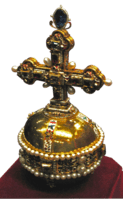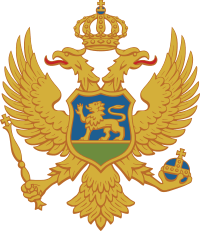Globus cruciger

The globus cruciger (Latin, "cross-bearing orb"), also known as the orb and cross, an orb (Latin globus) topped (Latin gerere, to wear) by a cross (Latin crux), has been a Christian symbol of authority since the Middle Ages, used on coins, in iconography, and with the sceptre as royal regalia. The cross represents Christ's dominion over the orb of the world, literally held in the hand of an earthly ruler (or sometimes it is held by an angel). In the iconography of Western art, when Christ himself holds the globe, he is called Salvator Mundi, the Saviour of the World; his statue is the Infant Jesus of Prague.
History



Holding the world in one's hand, or more ominously, under one's foot, has been used as a symbol since antiquity. To citizens of the Roman Empire, the plain round globe held by Jupiter represented the world, or the universe, as the dominion held by the emperor. A 2nd-century coin from the reign of Emperor Hadrian shows the Roman god Salus with his foot upon a globus, and a 4th-century coin from the reign of Emperor Constantine I shows him with a globus in hand. The orbis terrarum was central to the iconography of the Tetrarchy, representing the Tetrarchs' restoration of security to the Roman world. Constantine I claimed to have had a vision of a cross above the sun, with the words "In this sign, you shall conquer", at the Battle of Milvian Bridge in 312. His soldiers painted crosses upon their shields, and then defeated their foe, Maxentius.
With the growth of Christianity in the 5th century, the orb (in Latin scriptures orbis terrarum, the 'world of the lands', hence the word "orb") was topped with a cross (hence globus cruciger), symbolising the Christian God's dominion over the world. The emperor held the world in his hand, to show that he ruled it, on God's behalf. To non-Christians already familiar with the pagan globe, the surmounting of a cross sent a message about the triumph of Christianity. In medieval iconography, an object's size, relative to that of nearby objects, indicated its relative importance; so the world was small and the one who held it was large, to emphasise the nature of their relationship. Although the globe symbolized the entire Earth, its use spread among many Christian rulers (some of them not even sovereign) who reigned over small parts of the earth.
The first known use was probably in the early 5th century, possibly as early as between 395 and 408 on the reverse side of the coins of Emperor Arcadius, but most certainly by 423 on the reverse side of the coins of Emperor Theodosius II.
The globus cruciger was used by powerful rulers and celestial beings alike; it adorned portrayals of both emperors and kings, as well as archangels. It first appeared on coins in the early 5th century and remained popular throughout the Middle Ages in coins, iconography and royal regalia. The papacy, holding universal canonical jurisdiction and in the Middle Ages once rivalling the Holy Roman Emperor for the supreme feudal status of liege lord of all other (Catholic) rulers, also maintained the symbol on top of the papal tiara ("triple crown"; there is no separate papal orb). The crowned orb was in general use as a finial on western royal crowns, whether actual objects or merely heraldic crowns, all over Europe, for example in Denmark, Sweden, Belgium, the Netherlands, Italy, Spain, Portugal, Hungary, Romania, Yugoslavia and Imperial Germany, among others. It may still be seen in the national arms of the surviving European monarchies. Even in the modern era in England, the Sovereign's Orb symbolises both the state and Church of England under the protection and domain of the royal crown.
Gallery
-
A Roman Antoninianus coin showing Carinus holding pilum and globe.
-

Emperor Frederick I Barbarossa.
-

The Harris Tweed Orb
-

The Golden Bull of 1356 by the Charles IV, Holy Roman Emperor.
-

Frederick V holding the orb.
-

Elizabeth I of England in coronation robes and the orb and scepter
-

Austrian globus cruciger, part of the Austrian Crown Jewels
-

Regalia of Russia.
-

Holy Crown, Sword and Globus Cruciger of Hungary.
-

Virgin Mary with an orb on Our Lady Derzhavnaya icon
-

A generic globus cruciger as it may be used in heraldry
-

Coat of arms of Uppland
-

Orb and scepter in Montenegrin coat of arms
See also
- The Ball and the Cross
- Holy Hand Grenade of Antioch (satire of Globus cruciger)
- Monde (crown)
References
- Leslie Brubaker, Dictionary of the Middle Ages, vol 5, pg. 564, ISBN 0-684-18161-4
- Picture of the 10th century Orb, Scepter and Crown insignia of the Holy Roman Empire
External links
| Wikimedia Commons has media related to Globus cruciger. |
|




